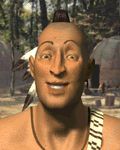The Iroquois |
|||||||||||||||||||||||
| Profile | |||||||||||||||||||||||
|
|||||||||||||||||||||||
|
Iroquois Cities
Great Leaders
|
Background
Loosely speaking, Iroquois is the term for any member of the Five (later, Six) Nations composed of several Native American tribes speaking a language of the Iroquoian family: the Cayuga, Mohawk, Oneida, Onondaga, Seneca, and Tuscarora (after 1722). At its greatest extent, the Five Nations occupied a vast territory around Lakes Ontario, Huron and Erie, in present-day New York state and Pennsylvania and southern Ontario and Quebec. Tradition credits the formation of the Iroquois Confederacy, forged between 1570 and 1600, to Dekanawidah, born a Huron, who is said to have persuaded Hiawatha, an influential Onondaga who had become the Mohawks’ war chief, to abandon cannibalism and advance “peace, civil authority, righteousness, and the great law” as sanctions for confederation. Cemented mainly by their desire to stand together against invasion, the five tribes united in a common council composed of clan and village chiefs; each tribe had one vote, and unanimity was the rule. In this form, the Iroquois used a combination of military prowess and skilled diplomacy to conquer an empire. Until their internal unity finally failed them during the American Revolution, the Iroquois dealt with even the European powers as equals. For nearly two centuries before the American Revolution, the Iroquois stood athwart the path from the Eastern coast to the Great Lakes, blocking the route to permanent settlement by the French and containing the Dutch and the English. Throughout the 18th century the Six Nations remained consistent and bitter enemies of the French, who were allied with their traditional foes, the Algonquins and Hurons. The Iroquois’ success in maintaining their autonomy from both the French and English was a remarkable achievement for an aboriginal people. But during the American War of Independence, a schism developed within the Iroquois Confederation. The Oneida and Tuscarora espoused the American cause, while the rest of the league, led by Chief Joseph Brant’s Mohawks, fought for the British, decimating isolated American settlements. Eventually, the villages, fields, orchards and granaries, as well as the morale of the Iroquois, were destroyed in 1779 when Major-General John Sullivan led a retaliatory expedition of 4000 American regulars, and crushed their assembled warriors near present-day Elmira. Having finally acknowledged defeat in the Second Treaty of Fort Stanwix (1784), the Iroquois Confederacy effectively came to an end by ceding western Pennsylvania, New York and Kentucky to the United States. At the end of the Revolutionary War, there were less than 8000 Iroquois left. Even the 1940 U.S. census listed only 17,000 Iroquois in both the United States and Canada, but current figures approach 70,000 in about twenty settlements on eight reservations in New York, Wisconsin, Oklahoma, Ontario and Quebec. Unique Unit: the Mounted Warrior The Mounted Warrior is an upgraded version of the horseman. Like the horseman, it requires horses to build, but it has an additional attack point, making it one of the best mobile assault units of the early eras.
|
||||||||||||||||||||||

 The Iroquois are expansionist and religious. They start the game with Ceremonial Burial and Pottery and build mounted warriors instead of normal horsemen.
The Iroquois are expansionist and religious. They start the game with Ceremonial Burial and Pottery and build mounted warriors instead of normal horsemen.  In Civilization III, the Iroquois represent all the tribes of Northern Native Americans. Though the Iroquois rarely used horse-mounted warriors in combat due to the wooded terrain they usually fought in, many other tribes frequently made use of them (notably the Sioux and other tribes of the Great Plains), and to great effect.
In Civilization III, the Iroquois represent all the tribes of Northern Native Americans. Though the Iroquois rarely used horse-mounted warriors in combat due to the wooded terrain they usually fought in, many other tribes frequently made use of them (notably the Sioux and other tribes of the Great Plains), and to great effect.